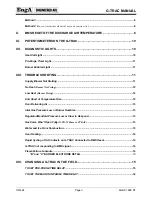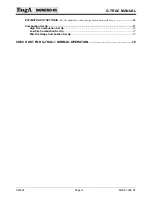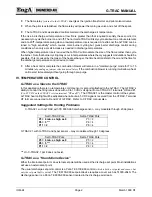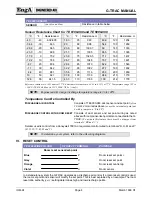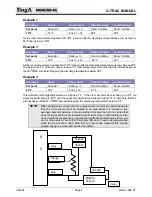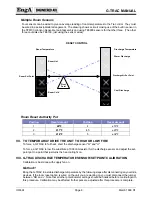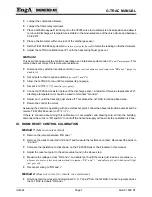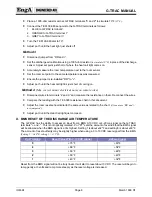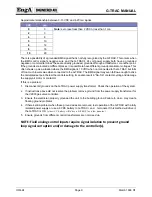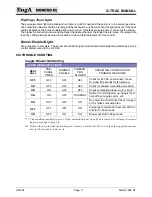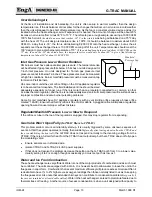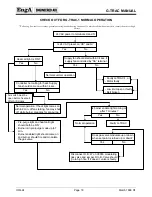
A
G-TRAC MANUAL
IOM-24
Page 13
March 1999 R1
Over Delivering Air
At the time of installation and air balancing, the unit is often set-up in warmer weather then the design
temperature rise. If the air balancer did not allow for the changes that will occur in air volume in cold weather
then the unit will appear to be short of temperature rise. As the fan is a constant volume device and as it is
located before the heat exchanger, air will expand as it is heated. The amount of change will be about 20%
increase in air volume from minus 30° F to 70° F. Therefore to give a rough sample, assuming a 10,000 CFM
100% fresh air unit
(located in an area that reaches -30
°
F in the winter)
was being air balanced on a 75ºF day
with the heat off. The unit design temperature rise is 100ºF. It should be balanced to deliver about 8,200
CFM. On a day that is -30°, the fan is still delivering 8,200 CFM onto the heat exchanger, but as the air
expands over the exchanger there is 10,000 CFM coming off of the unit. Temperature rise should meet the
100° design to give a discharge temperature of 70°.
(If the unit had been balanced to deliver 10,000 CFM on the
75
°
day, then on the -30
°
day noted above, the temperature rise would only be about 80
°
to give a final discharge
temperature of about 50
°
at about 11,800 CFM.)
Inlet Gas Pressure Low or Burner Rumbles
DG burners must have adequate inlet gas pressure. The temperature rise
will be affected if gas pressure falls below 6.5 inches on units designed for
7-inch inlet pressure. On units designed for 14-inch gas pressure inlet
pressure cannot fall below 12-inches. These pressures must be measured
at high fire conditions. Burner manifold pressure must be measured on tap
for Gordon Piatt Burners.
On some indoor units the vent orifice fitting on the RV appliance regulator
is to be vented to atmosphere. The field installed vent line should be sized
adequately especially on longer runs. If there is more than one regulator connected to a common run that
includes the main regulator, and the line is not adequately sized, an erratic inlet pressure will result and cause
improper combustion and also burner pulsating problems.
Some SJ unit manifolds have RV appliance regulators with a vent limiting orifice (usually a brass orifice
marked “12A06”). Ensure that this tiny orifice is free of dirt or debris. A plugged orifice will impede a regulators
opening flow and cause improper air/fuel mixtures.
Regulator/Manifold Pressure Low or Slow to Respond
If the orifice or tube in the top of the regulator is plugged, this may stop regulator from responding.
Gas Valve Won’t Open Fully
(G-TRAC Slave to CTRAC)
This problem seldom occurs at initial daily start-up. It is usually triggered by some unknown sequence of
events. At first the system operates normally, then suddenly
(usually after leaving a heat call on the CTRAC and
then re-establishing the heat call)
the G-TRAC does not respond normally to the incoming voltage from the
CTRAC. If there is a full call for heat from the CTRAC heat output ramp but the G-TRAC does not fully open
the modulating valve:
Ensure sensors are in shielded wire.
Isolate CTRAC and G-TRAC 24 VAC power supplies.
If that does not resolve the problem decrease the setting on the G-TRAC pot 5 from 3 to a lower value.
Usually setting it to 2 is enough though occasionally you must set pot 5 as low as 1.
Water and Ice From Combustion
These heat exchangers are very efficient. Water is one of the major products of combustion and as such must
be controlled. The units are equipped with a drain. It is however best to allow water to leave the unit in the
flue gases in vapor form. Combustion that is set at maximum efficiency will produce excess moisture. Often it
is desirable to have 1% to 2% higher excess oxygen readings then those normally listed to assist in keeping
the flue gases drier. Also note that extended chimneys can contribute to condensation problems
(especially if
they are not insulated or at least double walled)
. Water in the heat exchanger can lead to premature failure due to
thermal stress or freezing. Another source of excess condensation is when a unit designed with capacity to
Manifold
Pressure Tap
Summary of Contents for G-TRAC 1.1
Page 23: ...IOM 24 Page i March 1999 R1...

